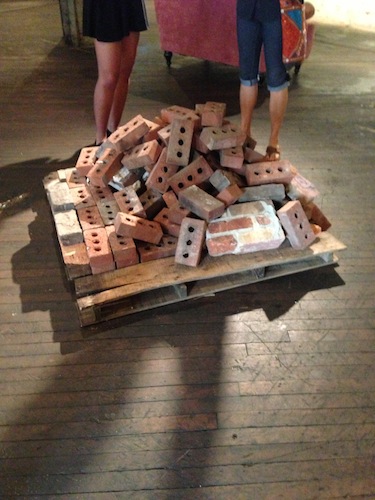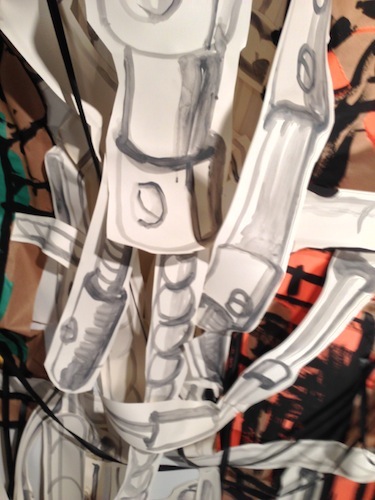The unifying concept for House Dignified at Area 405 is the, “use of location as portraiture to communicate notions of family, community, conflict, identity, and re-gentrification.” This exhibition was curated by Tyler Farinholt and features six artists: Amanda Burnham, Jessica Braiterman, Kathryn Cornelius, Margo Elsayd, Joshua Johnson, and Frank Perrelli.
As a former resident of the Detroit suburbs, including my stint as the curator for the Cranbrook Art Museum, I have some curatorial experience implementing the notion of place as the jumping off point for an exhibition concerning urban identity, decay and gentrification. These issues were the focus of an exhibition we hosted and co-organized called Shrinking Cities that premiered in Berlin in 2004 and came to Detroit and Bloomfield Hills, Michigan, in 2007. As this country recovers from the economic downturn of 2008, I was anxious to see how this theme continues in Baltimore, my current hometown.
Essentially, the show opens with Margo Elsayd’s Ode to Charm City series, including most visibly her “shanty” of found materials from Station North. Expectedly, planks of wood, scraps of metal, sheets of paper, street signs and the like are assembled to form a structure roughly the size of a phone booth, but smaller than a fishing shack. Such reconfigurations, no doubt, evoke slums, ghettos, waste and even recycling. The same is true for the pyramidal assemblage of bricks, also entitled Ode to Charm City, nearby. In the latter I was reminded of Scott Hocking’s Tire Pyramid from 2006 that was assembled from more than 2,000 discarded tires illegally dumped throughout Detroit. In his work the choice of materials was poignant given the allusion to Detroit’s once grand moniker as the Motor City. Turning back to Elsayd, I find it difficult to see where her installation at 405 injects a civic concern or a personal angle. A search for the artist’s previous projects show more thoughtful constructions, juxtapositions – such as the one that abutted the august Corcoran Gallery of Art – and aesthetic considerations.
Kathryn Cornelius employs photography to blur the line between reality and the perceived beauty of art. Her multiple views from the fridge to the table — modified or artificial — represent depressing realities of the impersonal and generic nature of the once common meal. Her photographs are updated variations on Daniel Spoerri’s “snare pictures” or assemblages of actual meals where the permanent and ephemeral are preserved and displayed including the silverware and cigarette butts. Cornelius’ self-portraits add a personal element and reinforce the fleeting nature of time. Anecdotally, I was left wondering if the bed to the right of Take All the Time You Need was meant to be a tableaux that relates to her self-portraits.
Frank Perrelli is the only true painter in the bunch, a frequent indicator that contemporary art, especially that which concerns urban reality, tends to eschew the quaint nature of pure painting. Octopus (2013) is the artist’s most complex work with the giant sea creature superimposed over a simplified variation on dense, Neolithic settlements that share walls, such as Çatal Höyük, now Turkey. Perrelli’s professional background in architecture, city planning and art history is impressive, but his work’s relationship to this show’s theme is difficult to see unless Farinholt is casting a wide net or being ironic. The inclusion of Perrelli’s dragonfly and daisies are equally perplexing. Are his creatures a modern day variation of King Kong that will terrify the modern metropolis?
Joshua Johnson’s works speak to the absurdities of mythology, the life of courtiers, grandiose architecture and possibly even religion. Think M.C. Escher meets Hieronymus Bosch. Working primarily in collage and paint, Johnson, according to the curator, “attempts to conjure a mythic composite of history-fantastic, unnatural and separate from contemporary life . . .” These themes, rich with satirical imagery, have applications today in Americans’ growing dissatisfaction of politicians, wealth inequality, and the vulnerability of the modern city and remind us of New York on 9/11, the natural destruction of New Orleans, and most recently the bankruptcy of Detroit. Aside from content, Johnson’s meticulous diorama is especially appealing.
Jessica Braiterman’s solo entry, Cloud Mountain (2012) was created from thread, yarn, wire and string. It’s near weightless nature and purity of white is an ethereal contrast to the gritty, urban setting of the space of 405. While I don’t see the relationship of this particular piece to the theme of the show as stated, except by way of contrast or irony (much like Perrelli’s work), I am grateful for its inclusion from a visual standpoint.
The most dramatic piece in the rear of the space is Amanda Burnham’s site-specific installation*. Using an earthy palette of brown, black, green, and white with a bit of yellow and orange, Burnham’s large-scale, mixed-media installation was specifically designed for 405’s exposed beams and intact character. Burnham references the interior space in addition to the architecture of Baltimore outside its doors including its Romanesque-inspired row houses. She uses broad, gestural strokes of black; assembled sheets of paper; and the exposed wall to create a commentary on the constant flux of urban strength and decay.
Some works in this exhibition followed the overarching theme of community, conflict and gentrification more strongly than others. Yet, that does not deny the strength of the works that stray. As for the curatorial decisions, it can be said that Mr. Farinholt acted boldly in his selections and was not afraid to take risks or stretch the theme. Notably, he did not rely on the obvious. For an exhibition entitled House Dignified, I expected the inclusion of at least one photographer to feature architectural ruins as a reference to Baltimore’s past. Or perhaps I am thinking about Detroit again.
*By way of disclosure, in 2012 I invited Burnham to participate in the annual Faculty Art Invitational at UMUC. (I wanted to move this to the end so it didn’t disrupt the flow of your writing.)
House Dignified is a showcased exhibition of the 2013 Artscape Gallery Network up through August 4, 2013 at Area 405, Baltimore.
Author Brian Young is the Curator at UMUC Gallery in Adelphi, MD.






